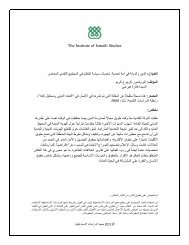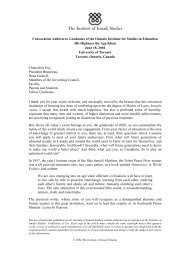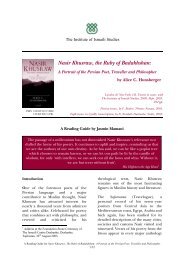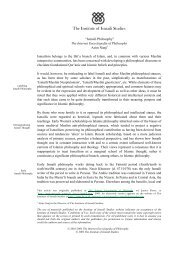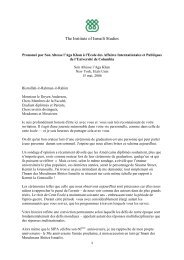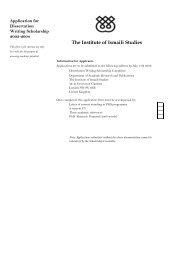The Institute of Ismaili Studies 1
The Institute of Ismaili Studies 1
The Institute of Ismaili Studies 1
Create successful ePaper yourself
Turn your PDF publications into a flip-book with our unique Google optimized e-Paper software.
the larger world <strong>of</strong> Sunni Islam. Consequently he publicly repudiated the doctrine <strong>of</strong> qiyama and<br />
ordered his followers to observe the shari‘a in its Sunni form, inviting Sunni jurists to instruct his<br />
people. Indeed, Imam Jalal-al-Din Hasan did his utmost to convince the outside world <strong>of</strong> his new<br />
policy. In 608 AH/1211 CE, the ‘Abbasid caliph al-Nasir acknowledged the Nizari imam’s<br />
rapprochement with Sunni Islam and issued a decree to that effect. Henceforth, the rights <strong>of</strong> Jalal al-<br />
Din Hasan to Nizari territories were <strong>of</strong>ficially recognised by the Abbasid caliph, as well as by the<br />
Khwarazm-Shahs, who were then establishing their own empire in Persia as successors to the Saljuqs,<br />
and by other Sunni rulers. <strong>The</strong> Nizaris accepted their imam’s new instructions without any opposition.<br />
<strong>The</strong>y evidently viewed Jalal al-Din Hasan’s declarations as a reimposition <strong>of</strong> taqiya, which had been<br />
lifted in qiyama times; the observance <strong>of</strong> taqiya could, thus, imply any type <strong>of</strong> accommodation to the<br />
outside world as deemed necessary by the infallible imam. Be that as it may, the Nizari imam had<br />
now successfully achieved peace and security for his community and state (Juvayni, III, pp. 243-49;<br />
tr. Boyle, II, pp. 699-704; Rashid al-Din, pp. 174-78; Kashani, pp. 214-17; Hodgson, 1955, pp. 217-<br />
25; Daftary, 1990, pp. 404-7).<br />
Under Imam ‘Ala al-Din Muhammad (618-53 AH/1221-55 CE), Imam Jalal al-Din Hasan’s son and<br />
successor as the penultimate lord <strong>of</strong> Alamut, the Sunni shari‘a was gradually relaxed within the<br />
community and the Nizari traditions associated with qiyama were revived, although the Nizaris<br />
continued to appear to outsiders in Sunni guise. <strong>The</strong> Nizari leadership now also made a sustained<br />
effort to explain the different doctrinal declarations and religious policies <strong>of</strong> the lords <strong>of</strong> Alamut. All<br />
these teachings were interpreted comprehensively within a coherent theological framework, aiming to<br />
provide satisfactory explanations for the seemingly contradictory policies adopted at Alamut.<br />
Intellectual life indeed flourished in the long reign <strong>of</strong> Imam ‘Ala al-Din Muhammad, receiving a<br />
special impetus from the influx <strong>of</strong> outside scholars, who fled the first waves <strong>of</strong> the Mongol invasions<br />
and took refuge in the Nizari fortress communities. Foremost among such scholars, who availed<br />
themselves <strong>of</strong> the Nizari libraries and patronage <strong>of</strong> learning, was Nasir al-Din Tusi, who made major<br />
contributions to the Nizari <strong>Ismaili</strong> thought <strong>of</strong> the late Alamut period during his three decades amongst<br />
them in Quhistan and Rudbar.<br />
It is mainly through Tusi’s extant <strong>Ismaili</strong> writings, notably his Rowzat al-taslim, that we have an<br />
exposition <strong>of</strong> Nizari thought <strong>of</strong> the Alamut period as it developed during qiyama and its aftermath.<br />
Qiyama, Tusi explained, was not necessarily a final eschatological event, but a transitory condition <strong>of</strong><br />
life when the veil <strong>of</strong> taqiya would be lifted to make the unveiled truth accessible. In the current cycle<br />
<strong>of</strong> history, however, the full qiyama, or Great Resurrection (qiyamat-i qiyamat) would still occur at<br />
the end <strong>of</strong> the era initiated by Prophet Muhammad. Be that as it may, the identification between<br />
shari‘a and taqiya, implied by the teachings <strong>of</strong> Imam Hasan II, was now made explicit by Tusi who<br />
also identified qiyama with haqiqa. Thus, the imposition <strong>of</strong> the Sunni shari‘a by Imam Jalal al-Din<br />
Hasan was presented as a return to taqiya, and to a new period <strong>of</strong> satr or concealment, when the truth<br />
(haqiqa) would be once again concealed in the batin <strong>of</strong> religion. <strong>The</strong> condition <strong>of</strong> qiyama could, in<br />
principle, be granted by the current Nizari imam at any time, because every imam was potentially also<br />
an imam-qa’im. Thus, Tusi now expounded a new doctrine <strong>of</strong> satr. In his integrated theological<br />
presentation, human life could alternate between periods <strong>of</strong> qiyama, when reality is manifest, and satr,<br />
when it would be concealed, requiring the observance <strong>of</strong> taqiya. In this sense, the term satr was<br />
redefined to imply the concealment <strong>of</strong> the religious truths and the true spiritual reality <strong>of</strong> the imam,<br />
and not the physical inaccessibility <strong>of</strong> his person, as had been the cases in the pre-Fatimid and early<br />
Alamut periods (Tusi, Rawza, text pp. 61-63, 101-2, 110, 117-19, 132-33, 143, 145, 147, tr. pp. 67-69,<br />
115-16, 126, 136-38, 154-55, 173, and elsewhere; Hodgson, 1955, pp. 225-38; Daftary, 1990, pp.<br />
…Please see copyright restrictions on page 1<br />
17



